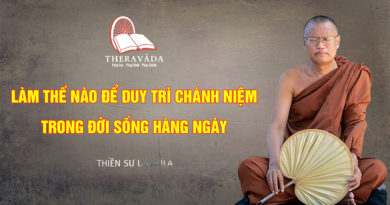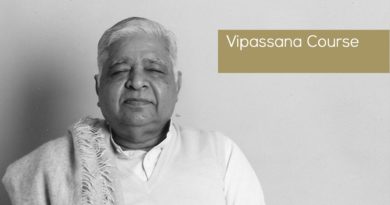Way To Nibbana Through Vipassana Meditation – By Mahasi Sayadaw
MAIN CONTENT
Vipassana Meditation – THE METHOD IN BRIEF (BY MAHASI SAYADAW)
Way to Nibbana
In spite of his endeavour to contemplate without a break to be able to note the phenomena not less than once in every second, a novice in the practice of meditation is apt to forget to observe quite a number of bodily behaviours and mental activities. As pointed out in the section on Samatha Meditation, there will be many nivaranas which cause the mind to wander to other objects.
What is important is that in practising Samatha meditation, there is no need to contemplate on the mind that forgets to observe, and the wandering mind, and that it is only necessary to recapitulate the original ‘samatha’ contemplation.
However, in the case of Vipassana meditation the mind that forgets to observe and the mind that wanders should be contemplated. Only after such contemplation with awareness, it should be reverted to the contemplation of the rising and falling of the abdomen and the arising of other phenomena. This is one of the points which essentially differs in dispelling nivaranas (five hindrances) between the practice of samatha-bhāvanāand that of vipassana-bhāvanā.
In the case of samatha-bhāvanā, one has to contemplate continuously on the object of samatha so that the mind is fixed on one single object only. It is not necessary to observe any other physical or mental phenomenon. Therefore, there is no need to contemplate on hindrances such as thoughts and imagination which arise occasionally. It is only necessary to dispel them as and when they occur.
In vipassana-bhāvanā, however, as the contemplation is to be made on all physical and mental phenomena arising at the six sense-doors. the popping up of nivaranas such as desires, greed, pleasurable feelings and wandering thoughts which sometimes escape the meditator’s notice, must be observed and contemplated. If not so contemplated, the mind will have its attachment to these nivaranas with a wrong view that they are permanent, pleasurable and ‘atta’ (Self). So, when such mental formations arise, it is not just enough to merely disregard them as in the case of samatha.
More convincingly, it may be stated that the task of vipassana practice will be accomplished only if contemplation is also made on them so as to know correctly the real nature with their natural and usual characteristics and to get detached from them. When repeated contemplation is made many times in the manner described above, the wandering mind will almost entirely disappear and with its disappearance, the mind will be free from hindrances. If the mind flits away from the object of contemplation, it can at onc e be noticed and contemplated, and by doing so the mind will immediately cease to wander.
Even at times when the mind tends to leave its contemplated object, it can immediately be observed and contemplated. The mind will then cease to wander making it possible to proceed with the usual contemplation without interruption. At this level of the contemplation, the contemplating mind always closely fits in fixedly with its object of contemplation. This fixedness of mind (samadhi) is Vipassana-khanikasamadhi (momentary concentration of insight).
The mind now being free from nivaranas such as kamma cchanda (sensuous lust) is, therefore, on equal footing with upacara-samadhi (proximate concentration) in the path of samatha-bhāvanā. As the mind is no longer mixed up with any hindrances that cause the mind to wander, and being purified forming a continuous chain of identical thoughts deep in one-pointedness of the mind in the act of contemplation, it is called Citta- Visuddhi(Purity of mind). Then the material or physical phenomena such as, rising and falling (of the abdomen) etc., which are being observed and noted, are perceived at every moment of contemplation distinctively without mixing up with the knowing mind (nama) and other material objects (rupa).
Stages of Insight-Knowledge
Also, the mental phenomena such as the act of contemplating, consciousness of thoughts, act of seeing, etc., are also perceived at every moment of contemplation as distinguished from material phenomena and other mental phenomena. Even at every moment of breathing, the body that is known and the knowing mind are observed and noted with clear distinction. This knowledge of discernment distinguishing between mind and matter is known as “namarupa-pariccheda ñana.” When this insight-knowledge has been developed many a time, the known material object such as the phenomena of ‘rising and falling’ and the knowing mind which realizes the act of seeing, knowing, etc., are clearly understood as being only rupa (matter that has no sensitivity of knowing things) and ‘nama’ (mind which has the power or sense of knowing, seeing or feeling the material objects and mental activities) which in fact constitute the two main factors of this bodily existence.
Apart from these two constituents of life existence, there is no ‘atta,’ or Self, and knowing this well one becomes elated. This realization of knowledge in the course of contemplation is called “Ditthi- Visuddhi” (Purity of View). On proceeding further with the contemplation, it will be appreciated for having perceived that the material and mental phenomena that are arising in the body are the results of cause and effect.
For illustration: The disciple is pleased for having perceived the fact that because of the mind intending to bend or stretch or move or change the posture, there arise the action of bending, stretching, moving; or changing; because of the fluctuations of temperature, condition in the physical body changes either by being hot or cold; and because of the partaking of food there arises formations of the physical energy. Again he perceives with satisfaction that because of the presence of the eye and visual object, ear and sound, etc., the act of seeing, hearing etc., has occurred; and because of the volitional attentiveness, the mind reaches its sense-object. Again, he perceives with entire satisfaction that because of ‘Avijja’ (ignorance or delusion) things appear as being fine and pleasurable; because of ‘tanha’ (cravings) all kinds of deeds are performed after premeditation, being willing to get better-off and delighted or obtain satisfaction: and because of attachment to such actions, thoughts and performances there arise afresh ‘viññana’ (consciousness): and that the phenomenon of death is nothing but the eventual passing away or disappearance of such consciousness; and that the new life existence (another birth) is the resurgence of such mental consciousness together with the new corporeal body to be depended upon, and so forth.
This distinguishing knowledge of Dependant Origination of cause and effect is known as “paccayapariggahaña na” (the knowledge that distinguishes between cause and effect). When it is realized that this process of Dependent Origination is result of the relativity of cause and effect, he becomes aware of the fact that matter and mind (rupa and nama) had also arisen in the past and that in future also similar occurrences of matter and mind will again take place. Such realization of knowledge with inner satisfaction is called ‘Kankha-Vitarana-Visuddhi’ (purity arising from having overcome doubts).
Before the realization of the right knowledge of rupa and nama as being taking place within the law of cause and effect, many sceptical doubts could have arisen as to whether there was such a thing as “I” or atta or “Self” in the past falsely viewing rupa and nama as ‘atta’ and a living entity! And that doubts may arise whether “I” come into existence only now and whether “I” in the sense of “Self” will exist hereafter, after death? Now that these sceptical doubts cannot possibly arise. It means that such doubts have been overcome. On proceeding further with the contemplation it will be observed that all rupa and nama arise and pass away at every moment of contemplation.
For this reason the phenome nal nature of their impermanence will be known and appreciated. This is “Anicca-sammasana-ñana.” (Insight into the impermanent nature of phenomena). It will also be observed and perceived that the natural phenomena of rupa and nama are constantly taking place and that this arising and passing away of matter and mind have incessantly caused sufferings, and therefore, they are neither pleasant nor reliable, and are terribly miserable and distressing. This is “Dukkha-sammasana-ñana” (Insight into ill-condition). Realizing the fact that these conditioned things are happening on their own volition and that their phenomenal occurrences do not follow the dictates of one ‘s own will, they are observed and perceived as neither “atta” nor “Self” but merely “anatta” (Not-self). This is “Anatta-sammasanaña na” (Insight into non-atta or non-self). After having made an analytical observation and reflection on these facts with entire satisfaction, the disciple proceed with his contemplation as usual without further reflection. At this stage, he will clearly perceive the beginning of the arising of sensation towards the sense-object at every moment of his contemplation. He will also perceive the coming to an end of this sensation which is completely severed. At this juncture there may arise many other strange happenings, such as:
Ten Imperfections of Insight
(1) mental visions of brilliant or bright light
(2) arising of rapturous feelings
(3) arising of feelings of calmness
(4) strong devotional feelings relating to Buddha and Dhamma
(5) great enthusiasm to carry out the practice of meditation
(6) joyful feelings
(7) extremely rapid, clear and purified perception of senseobjects
(8) the capability of practising mindfulness without missing to note any sensation that needs be contemplated.
(9) the capability to contemplate automatically without making particular effort.
(10) feeling of subtle pleasure in the contemplation.
The meditator (disciple) is so much encouraged and elated that he cannot remain mute and cannot help recounting his experiences. This is just an initial or immature stage of “Udayabbhaya-ñana” and a misconception of “maggañana.” In fact, it is only through the knowledgeable experience of the scriptural texts or the instructions of the meditation teacher that decision should be arrived at with faith whether such vision of brilliant light, etc., are not the true Enlightenment and that spiritual enlightenment can be achieved only by contemplating continuously on all material and mental phenomena that arise, through the practice of Vipassana.
The making of such a decision is known as Maggamagga-ñanadassana- visuddhi” (Purity of insight into right and wrong paths). After having come to this decision if the contemplation is carried on in continuity, those feelings of contentment and satisfaction and mental visions of light will gradually decrease, and the perception of the objects will become clearer and clearer with awareness.
The gradual arising and dissolution of numerous phenomena with all their movements taking place at a snail pace will be clearly perceived fragment by fragment, in the course of a single act of bending or stretching the arm or the leg or of taking a step, before it even reaches from one stage of a series of movement to another, that is, without reaching the end of a chain in the consecutive movements of the limb from one position to another. This knowledge is the mature form of “Udayabbhaya-ñana,” flawlessly free from ‘Upakkilesa’ (impurities). When this ‘ñana’ has gained more strength, the perception of the phenomenal sense-objects becomes accelerated. Therefore, the end-vanishing of the sense- feelings is more clearly manifested and becomes more noticeable than the beginning of their arising.
Then, all sense-objects would appear as if they have already vanished. Forms and shapes of hand, leg, head, body, etc., are no longer perceived and are found to be fading away followed by dissolution every time contemplation is made. It is also perceived with awareness that even the contemplating mind along with its objects of contemplation vanishes one after the other immediately in succession. This knowledge and awareness of the process of vanishing in pairs of the sense-object and the knowing mind at every moment of contemplation is called “Bhanga-ñana” (Insight into the dissolution of things).
Having perceived that both the knowing mind and the phenomenal sense-objects are constantly passing away, there arises the knowledge that they are really frightful. This knowledge is, however, viewed with pleasure. This is “Baya-ñana” (Awareness of frightful condition). Then there arises the realization of the fact that these psycho-physical phenomena so rapidly dissolving are undesirable being faulty and defective in nature. This is “Adinava- ñana” (Insight into unsatisfactory condition). On proceeding with the contemplation, awareness of the unattractive and boring nature of things takes place.
This is “Nibbida- ñana” (Insight into wearisome condition). Then, knowledge or awareness also occurs looking forward to escape from the misery and sufferings brought about by those phenomena of arising and passing away of rupas and namas, and thinking at the same time that it would be better if these physical and mental phenomena cease to exist altogether. This knowledge is “Muccitu-kamyata- ñana” (Knowledge or insight arising from desire to escape).
At this stage, as contemplation is carried on with most anxiousness for an escape (deliverance), a clear perception of ‘anicca,’ ‘dukkha’ and ‘anatta’ would arise. In particular, the nature of dukkha, sufferings, may be perceived very convincingly. This is “Patisankha- ñana” (Insight arising out of further contemplation). When this ‘Patisankha- ñana’ is fully strengthened, contemplation and awareness become automatic and proceed on its own like the machine of a clock. It proceeds contemplating on objects with equanimity, i.e., superficially taking notice of them, and avoiding to pursue the arising of good or bad sensations. It is so very delicate and gentle. Such contemplation may go on automatically with awareness as it gains momentum for one hour, two ho urs or three hours.
Even though it may last so long, there will be no tiredness or exhaustion. The realization of the true nature of the objects of contemplation without exertion and without pursuing good or bad sensations in the course of the contemplation which lasts for a long time is “Sankharupekkha- ñana” (Knowledge or insight arising from viewing things with equanimity). While such realization is going on automatically, extremely fast and active knowledge reappears and this knowledge which advances with a big rush towards a noble path known as “Vutthana- magga” is called “Vutthana-gamini. vipassana- ñana” (Insight leading to elevation). That special knowledge appears with the realization that physical and mental phenomena which occur at the six sense-doors momentarily are impermanent, suffering and ‘not-self’ (anatta). The knowledge that arises at the last moment is “Anuloma- ñana” (Knowledge of adaptation) which consists of three ‘javanas,’ impulse moments, called ‘Parikamma’ (preparation), ‘Upacara’ (approach) and ‘Anuloma’ (adaptation).
This is the “Ñana” that is gained in consonance or in harmony with the preceding eight “Vipassana- ñana” and subsequent “Magga- ñana” (Knowledge of the Path). Insights from the mature “Udayabbaya-ñana” to the “Anuloma-ñana” totalling nine in number are collectively known as “Patipada-ñana-dassana-visuddhi” (Purity of knowledge and insight arising from having followed the course of practice). After ‘Anuloma-ñana,’ there arises “Gotrabhu-ñana” (Knowledge overmastering kinship) which grasps the sensation towards Nibbana where the miseries and sufferings connected with rupa and nama entirely cease. This is the knowledge which severs the lineage of ‘puthujjanas’ (worldlings) and enters the lineage of the ‘Ariyas’ (Noble Ones).
Stream-Enterer
Then, there arise “sotapatti Magga and Phala Ñana” (Insight wisdom arising from the Noble Path of Stream-winning and its Fruition) which realises Nibbana. The ‘Maggañana’ is called “Ñanadassana- visuddhi” (Purity of insight). The moment of arising of the ‘magga and Phala Ñana’ does not last even for a second. Then retrospective reflection of the peculiar experiences of the “Magga, Phala and Nibbana” takes place. This is “Paccavakkhana-ñana” (Insight of retrospection). One who has acquired knowledge up to the stage of ‘paccavakkhana-ñana’ seriatim to the procedure outlined above, is a “Sotapanna” (Stream-Winner). A Sotapanna is free from the following three ‘Samyo janas’ (fetters):
(1) Sakkaya-ditthi-Erroneous view of matter and mind (rupa and nama) as a living substance, ego or ‘self,’ i.e., Personality Belief.
(2) Vicikiccha-Doubt or uncertainty of the belief about the Buddha, Dhamma, Sangha, and the discipline, and about the practice of moralities.
(3) Silabbata-paramasa-Belief in ritualism; wrong belief that methods other then that of cultivating the equalities of the (Eightfold) Ariya-magga (Noble Path) and developing vipassana insight will lead to Nibbana. Eternal Peace; Indulgence in wrongful rites and ceremonies.
Furthermore, in the case of a Sotapanna, his observance of the five precepts, morality, remains pure and unpolluted as a matter of course. For these reasons, a Sotapanna is liberated from the four Nether Worlds and after being reborn in the world of human beings and devas for seven existences at the most he will attain Arahatship in his last seventh existence and pass into Nibbana. If a Sotapanna practises vipassana meditation with a view to getting to the state of phala, which he has once acquired, he will reach ‘phala-sammapatti’ and remain in that state for a duration of five or ten minutes or half an hour or one hour as he may predetermine. If he is an adept in his practice of ‘phala-sammapatti,’ he can easily get himself absorbed in that state for a whole day or a whole night or longer.
If he carries out the contemplation of “Upadanakkhandhas” in the same manner aiming to realize the higher states of magga-phala to which he has not yet reached, vipassana-ñanas will be developed from the stage of Udayabbaya-ñana in the serial order as before, and on full maturity, he will realize Nibbana with the insight-knowledge of “Sakadagami-magga-phala” (Path and fruition leading to the state of the Once-Returner), and become a Sakadagami. (Once-Returner). A Sakadagami is free from coarse sensuous cravings (kamaraga) and coarse byapada’ (illwill).
Therefore, a Sakadagami will attain arahatship and enter Nibbana only after two existences at the most, in the world of human beings and devas. When a Sakadagami carries out the practice of ‘vipassana’ with intention to reach the state of ‘magga and phala’ which he has once accomplished, he will achieve that state and if the practice of vipassana meditation is proceeded with in the same manner so as to realize the higher state of magga-phala, he will attain Nibbana with the insight of “Anagami-magga-phala” (Path and fruition leading to the state of ‘Never-Returner’ and become an “Anagami.” An Anagami is absolutely free from ‘kamaraga’ and ‘byapada’ and will never be reborn in the world of human beings or of devas, but only in Brahma World of Form or Formless Sphere from which he will attain Nibbana after becoming an Arahat.
If an Anagami wishes to get to the state of phala-sammapatti and carries out the practice of vipassana, he will reach his objective. If he continues vipassana meditation with a view to attaining higher states of magga-phala, the Vipassana-ñana’ will become developed stage by stage to the extent of achieving the realization of Nibbana and will attain Arahatship. An Arahat is absolutely free from the remaining five ‘Samyojanas,’ namely:
(1) Rupa-raga (craving for material existence)
(2) Arupa-raga (craving for immaterial existence)
(3) Mana (conceit)
(4) Uddhacca (restlessness)
(5) Avijja (ignorance or delusion together with all ‘kilesas,’ defilements)
Therefore, an arahat will never be reborn in a new existence. At the end of the life-span in this existence he will enter into “pari nibbāna .” As there is no more rebirth for him after the parinibbāna, he will escape from all miseries and sufferings of old age, sickness, death etc., etc. It is with this objective to get the benefit of being liberated from these miseries and sufferings, that the following question has been raised and answer given to it at the very outset of this treatise. Q. Why should meditation meditation be practised? A. meditation meditation should be practised so as to reach Nibbana, thereby escaping from all kinds of misery, such as old age, death, etc. May all those who earnestly wish to get liberated from old age, death and other kinds of misery through realization of Nibbana be able to practise meditation as duly instructed herein and speedily attain the Eternal Peace of Nibbana.
Source: http://www.yellowrobe.com/practice/meditation/228-way-to-nibbana-through-vipassana-meditation.html


![Videos [khóa Thiền Vipassana 2017] 14. Vì Sao Thiền Sinh Tiến Bộ? | Thiền Sư U Jatila 2 14 8](https://satima.net/wp-content/uploads/2020/07/14-8-390x205.png)


![Videos [khóa Thiền Vipassana 2018] 07. Kinh Ananda (phần 2) | Thiền Sư U Jatila 5 7 9](https://satima.net/wp-content/uploads/2020/07/7-9-390x205.png)

![Videos [khóa Thiền Vipassana 2017] 1. Cách Hành Thiền | Thiền Sư U Jatila 7 1 7](https://satima.net/wp-content/uploads/2020/07/1-7-390x205.png)